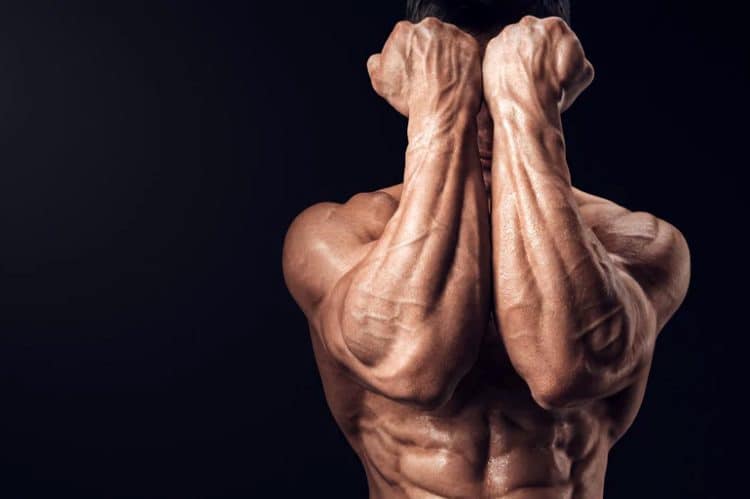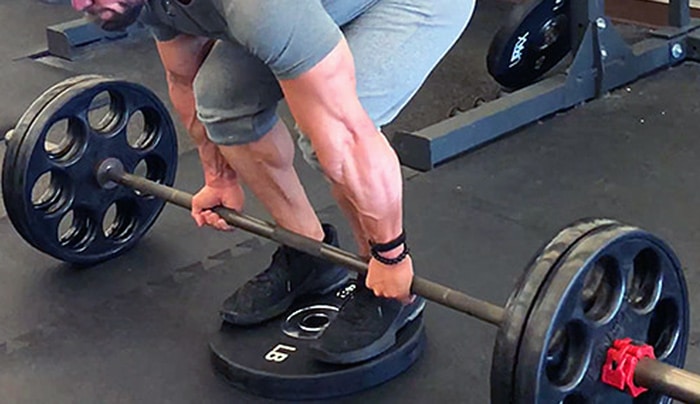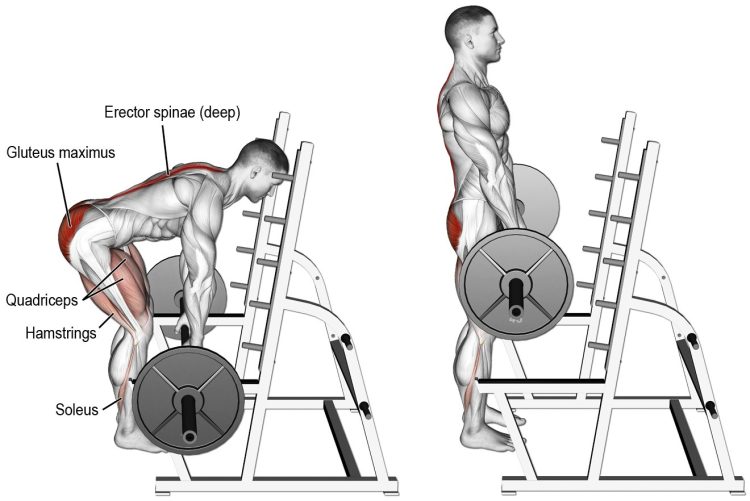The deadlift is the most productive exercise you can do with a barbell – period. Whether you want to build muscle, get stronger, improve your sports performance, or get leaner, the deadlift can help. In fact, it should be the cornerstone of your workout!
Deadlifts work so many muscles at the same time that they almost qualify as a full-body exercise. In fact, paired with something like bench presses, push-ups, or dips, you’ll get a full-body workout in just two moves. Talk about training efficiency.
The deadlift is such a valuable exercise that, in Victorian times, it was called “the health lift” and prescribed by the doctors of the day to treat a wide range of medical maladies.
Deadlifts also teach you how to safely lift heavy objects off the ground – by using your hips and legs and without rounding your lower back.
But the deadlift is more than a superbly productive exercise – it’s also one of the best ways to test your strength. If you fail to complete a rep, you can just drop the bar and walk away unscathed. The same cannot be said for squats or bench presses.
Increasing your deadlift will have a measurable effect on your physique and physical performance. Plus, few things are as satisfying as loading a barbell with a load of bumper plates and then seeing the bar bend as you pull it off the floor.
In this article, we reveal 10 proven ways to boost your deadlift performance.
-
Ten Ways to Boost Your Deadlift
- 1. Become a Deadlift Master
- 2. Deadlift Twice a Week
- 3. Strengthen Your Grip
- 4. Strengthen Your Core
- 5. Improve Your Power and Speed
- 6. Improve Your Strength Off the Ground with Deficit Deadlifts
- 7. Increase Your Mid-range Strength with Rack Pulls
- 8. Strengthen Your Lockout with Chains or Bands
- 9. Beef up Your Upper Back
- 10. Give Sumo Deadlifts a Try
- Boost Your Deadlift – Wrapping Up
Ten Ways to Boost Your Deadlift
Whether you want to increase your 1RM, do more reps with a heavy weight, or become a more proficient deadlifter, use these strategies to achieve your goals!
1. Become a Deadlift Master
The deadlift is pretty simple; just bend down, grab the bar, and stand back up again, right?
But despite looking straightforward, the deadlift is a surprisingly technical lift. Things like stance width, hip position, and bar path can have a huge impact on your deadlift performance and affect how much weight you can lift.
So, video your deadlift performance and look for any obvious technical faults such as:
- Rounded lower back
- Hips rising faster than your shoulders
- The bar moving away from your legs
- Trying to “squat” the weight up
- Falling forward onto your toes
Identifying and fixing these faults should be your first priority when trying to improve your deadlift performance.
For more information on correct deadlifting form, check out this article.
2. Deadlift Twice a Week

If you want to get better at something, you need to do it frequently, and that includes deadlifting. So, if one deadlift workout per week is not producing the results you want, why not try two?
Two deadlift workouts per week will give you more opportunities to work on your technique and twice the training stimulus for faster gains.
That doesn’t mean you should do the same deadlift workout twice a week, as that’s a good way to get bored and injured. Instead, do different deadlift variations to keep your workouts interesting and productive.
For example:
| Workout 1 | Workout 2 | |
| 1. | Conventional Deadlift | Deficit Deadlift |
| 2. | Good Morning | Romanian Deadlift |
| 3. | Leg Curl | Glute-Ham Raises |
In addition to alternating exercises workout by workout, it’s also a good idea to use different set and rep schemes. For example, you might do five sets of five one day and three sets of eight the next.
3. Strengthen Your Grip

If you want to deadlift heavy weights, you need a vice-like grip. After all, if you can’t keep hold of the bar, you won’t be able to lift it even if the rest of your body is strong enough.
You can get around a weak grip by using lifting straps, but that’s a short-term fix to a long-term problem. A better option would be to strengthen your hands and forearms with some specific grip-building exercises.
Good deadlift-specific grip exercises include:
Finish your deadlift workouts with some targeted grip training or, better yet, train your grip 2-3 times a week to increase your hand strength even faster. Improve your grip on the bar by using lifting chalk. It helps soak up any sweat, making your hands less likely to slip.
4. Strengthen Your Core

Whether you wear a weightlifting belt or prefer not to, you need a strong core to deadlift big weights. The core is the collective term for the muscles of your midsection. It includes the rectus abdominis, obliques, transverse abdominis, and erector spinae.
Your core supports and stabilizes your spine during deadlifts so that the forces generated by your legs are transferred efficiently to the barbell in your hands. If your core is weak, you may find your hips rising while the barbell stays still, which, as well as being dangerous, is a waste of valuable lifting energy.
During deadlifts, your core works isometrically or statically to generate intra-abdominal pressure (IAP) and abdominal stiffness. Exercises like crunches and sit-ups are not very deadlift-specific.
If you want to train your core for deadlifts, you need to include static core exercises in your midsection workouts.
Good choices include:
- Pallof presses
- Russian kettlebell challenge (RKC) planks
- Single-arm farmer’s walks
- Suitcase deadlifts
- Weighted planks
5. Improve Your Power and Speed
Deadlifts are so-called because each rep starts with the bar resting on the floor; it’s a dead weight. Getting a stationary weight moving is not easy and is called overcoming the moment of inertia.
The most efficient and effective way to get a deadweight moving is with speed and momentum. That means you should start your deadlift by trying to lift the weight as fast as possible.
Of course, because the weight is heavy, it will not fly off the floor. However, by trying to lift the bar as explosively as possible, you will increase muscle engagement, resulting in more force being produced.
You can increase your power and speed off the floor with various assistance exercises, including squat jumps, box jumps, power cleans, and kettlebell swings, all of which deserve a place in your deadlift workouts.
Related: The Best Power Exercises That Aren’t Olympic Lifts
6. Improve Your Strength Off the Ground with Deficit Deadlifts

As discussed above, getting a heavy weight moving takes an inordinate amount of effort. Mean old Mr. gravity really puts up a fight, and he doesn’t want to let go of that barbell!
If you find it hard to break the bar away from the floor, you need to increase your strength at the start of your rep. One of the best ways to improve your strength off the floor is deficit deadlifts.
Deficit deadlifts involve standing on a low platform, such as a couple of bumper plates. This increases your range of motion and forces you to start each rep in a biomechanically disadvantaged position. The resulting increases in strength will have a significant impact on your regular deadlifts.
Read more: You can learn all about deficit deadlifts here.
7. Increase Your Mid-range Strength with Rack Pulls

A lot of lifters find that their deadlift stalls at around knee height. This is frustrating and understandable as this is where leverage is usually at its most disadvantageous.
If your deadlift grinds to a halt mid-rep, rack pulls may help.
Rack pulls involve starting your deadlifts with the bar resting on power rack pins set to around knee height or wherever your deadlift typically stalls. By focusing on this weakness, you can develop the strength you need to power through your sticking point.
No power rack? No problem! You can achieve a similar effect by placing your barbell on blocks or stacks of weight plates.
Read more: Rack pulls guide.
8. Strengthen Your Lockout with Chains or Bands
Deadlifting with chains or resistance bands increases the weight as you approach lockout.
As well as overloading the upper range of motion, using bands or chains teaches you to lift more explosively and develops your ability to use speed to blast past your sticking points.
Bands and chains have a similar effect, but while some gyms have chains, bands are cheaper, lighter, and more portable.
So, if your gym doesn’t have chains, buy a set of bands and keep them in your workout bag. Bands can also be used for bench presses, squats, and several other exercises.
9. Beef up Your Upper Back

A weak upper back will limit your deadlift performance. During deadlifts, your lats are responsible for keeping the bar close to your legs which creates a better, more efficient line of travel for the bar.
Also, your upper back pulls your shoulders down and back, minimizing unwanted movement.
So, if you want to build a bigger deadlift, you need to strengthen your upper back. Forget lightweight exercises like lat pulldowns and seated rows. Instead, train your back hard and heavy.
Some of the best exercises for back strength include:
10. Give Sumo Deadlifts a Try
There are two recognized techniques for deadlifts – conventional and sumo. Conventional deadlifts are the most common and are done with a shoulder to hip-width stance, hands outside the legs.
In contrast, sumo deadlifts are done with your feet about 1.5 shoulder-widths apart and your hands inside your legs.
A lot of powerlifters favor sumo deadlifts, and switching to sumo may allow you to lift more weight. Depending on your height, mobility, and arm length, you may find conventional deadlifts better than sumo or vice-versa.
We can’t tell you if sumo will work better for you than conventional deadlifts. The only way to find the best deadlift technique is to try them both and compare your progress.
Check out our guide Traditional Vs. Sumo Deadlift, Which Type is Best for You? to learn more about the differences between these two lifts.
Boost Your Deadlift – Wrapping Up
Providing you can do them safely, everyone who trains with weights should do some kind of deadlift. It’s such a productive exercise that it should be made compulsory! Whatever your reason for exercising, the deadlift will help you get there sooner.
Of course, you also need to learn how to deadlift properly. While the deadlift is the best back-builder around, it’ll also break you if you do it incorrectly. The deadlift demands your respect!
Use the strategies and tips in this article to take your deadlift to the next level. Improving your deadlift will have a huge knock-on effect on the rest of your workouts, boosting strength and muscle growth in the process.


